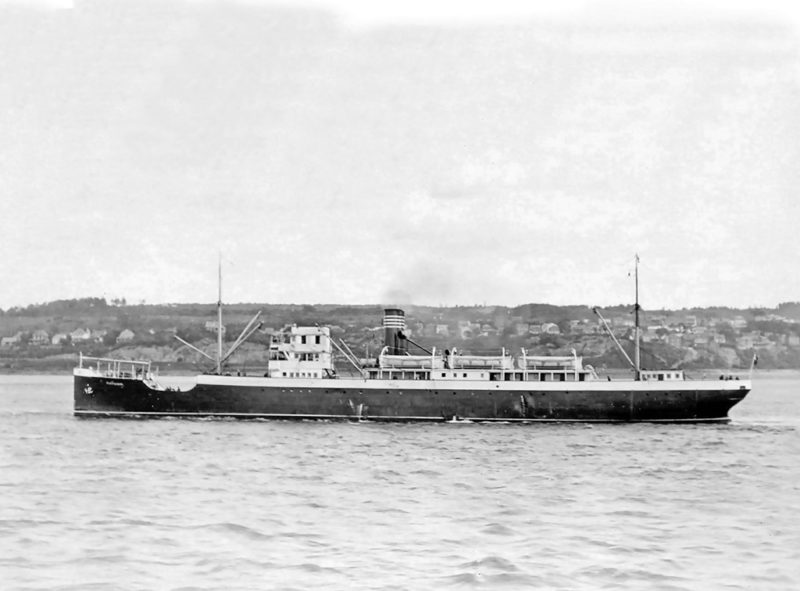
The Clarke family of four Toronto born brothers of Irish descent were running a prosperous publishing house in Toronto with contracts for several important British publishers e.g. Encyclopedia Britannica in the late 19th century. William, the eldest, James and George visited in their yacht an area to the west of Sept Iles at location 50°11′ North, 66°8′ West in 1899 as a site for building a pulp and paper mill for their Gulf Pulp & Paper Company, and thus to feed paper for their Toronto publishing house. The site was twenty kilometres west of the centre of Sept Iles and construction of the mill was underway in 1903 using workers from the Magdalen Islands in the Gulf of St. Lawrence. This was only the second pulp and paper mill in Quebec province, the first had been built at Chicoutimi in 1898, and the mill began exporting pulp in the Autumn of 1908 to England. A hydroelectric power station was also built in 1908 to provide power, and the new town of Clarke City had a population of 400 people in 1908.
William Clarke and his wife Mary Maguire Clarke plus their four sons and daughter moved house to Clarke City in 1905. Frank William Clarke was the eldest (born 16th June 1887), Walter Clarke (born 30th January 1889), Desmond Arthur (born 9th January 1892), Wilfrid (born 5th July 1896) were followed by a daughter Hilda born in 1900. Clarke City was later amalgamated into the city of Sept Iles in 1970 and is now a western suburb of the city. A preserved six wheel steam locomotive and tender belonging to the Gulf Pulp and Paper Company, the Clarke company, is kept in good condition today in Sept Iles.
The Clarke City pulp and paper mill greatly helped the World War I effort, with Walter and Frank wishing to stay with the Gulf Pulp & Paper Company after the war, while Desmond Clarke founded the Clarke Steamship Co. Ltd. in February 1921 one hundred years ago. The company signed a contract with the Dominion Goverment to provide subsidised passenger and cargo services to both shores of the St. Lawrence. The authorised capital of the shipping company was $1 million, and two steamers, each of around 1,000 grt were purchased in April 1921 for a North Shore passenger and cargo service from Quebec to the many small towns and trading posts on the St. Lawrence as far as Bradore Bay near Blanc Sablon on Belle Ile Strait. These were the clipper bowed North Shore of 880 grt, built on the Tyne by William Dobson as Queen Olga Constantine for a Russian company, and Gaspesia of 1,014 grt built at Rostock in 1909 with engines ‘midships, two holds and two masts.
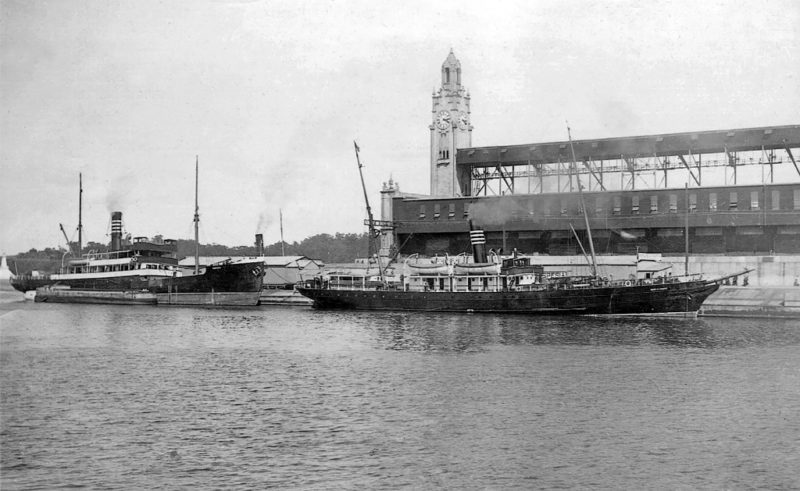
North Shore of 880 grt had arrived from North Shields as Novaia Zemlia at the end of April 1921, and was quickly renamed and sailed from Quebec and arrived at Havre-Saint-Pierre on the Pointe-aux-Esquimaux (Eskimo Point) peninsula on 7th May 1921 on the first voyage. The North Shore had accommodation for 100 passengers (50 First Class and 50 Third Class), and the Gaspesia had accommodation for 136 passengers, with 43 in berths. Havre-Saint-Pierre lies 120 miles East of Sept Iles, and quickly gained the Labrador Stores establishment at the head of the dock. The people are descended from Acadian families in the Magdalen Islands and speak an Acadian French dialect rather than Quebec French, the population being 3,500.
A South Shore cargo and passenger service from Quebec to Gaspe was begun at the same time by the purchased former coastal defence trawler Labrador of 317 grt and built by Davie Shipbuilding & Repairing at Lauzon opposite Quebec in 1918. The service was extended in 1922 to the Magdalen Islands and later to Charlottetown (Prince Edward Island) and Pictou (Nova Scotia). At the end of the Autumn 1923 season before the freeze up on the St. Lawrence, a trial service was made from the South Shore service to Port aux Basques on south west Newfoundland, with cargo then forwarded by the Newfoundland Railway Company to Corner Brook, where a large paper mill was being constructed on the west coast. The first paper was produced at the mill in 1925, by which time the South Shore service had become direct to Corner Brook and the other Bay of Islands ports of Curling and Humbermouth, and was then extended to Loch Lomond near Doyles. Labrador was sold in 1930 to the Canadian Government for use as a lighthouse tender.
Chartered ships on the North Shore Service included Aranmore of 1,170 grt built in 1890 by W. B. Thompson & Co., Dundee for the Clyde Shipping Co. Ltd. She became a Canadian Government lighthouse tender in 1914 and after being aground on the west coast during the winter of 1919/20, she was refloated and short term chartered in late 1921 by the Clarke Steamship Company to replace North Shore while she underwent repairs. Two ‘Flower’ class sloops built in 1917/18 were purchased by Cayzer, Irvine & Co. Ltd., Glasgow for bareboat charters to the Clarke Steamship Company as Nayarit and Colima in 1925. They were returned to their Clan Line owner a year later after their North Shore voyages. Nayarit returned to Clarke Steamship Company in 1929 when she was purchased outright and renamed North Voyageur and lasted until sold to Greek owners in 1937. She had accommodation for 80 passengers but this was reduced to 60 passengers during the Depression, when she was laid up for two years. North Shore ran aground on 12th August 1933 on Les Islets Caribou on the Calumet River while on a special voyage from Rimouski, and was refloated four days later but her damage was extensive and she was broken up at Sorel.
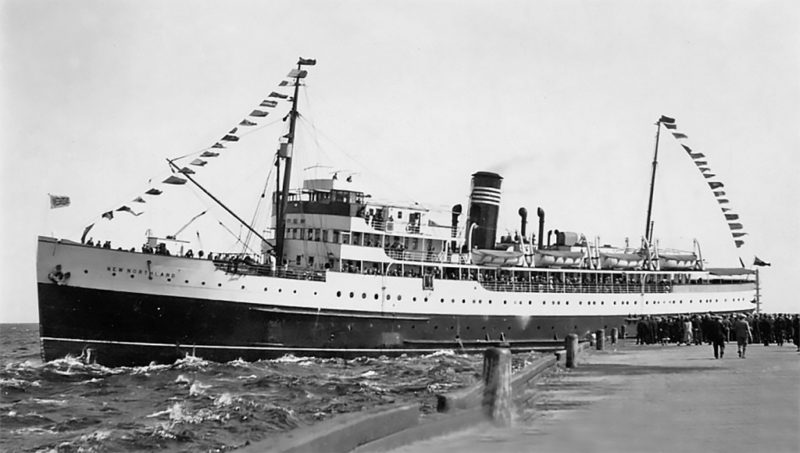
The funnel colours of the Clarke Steamship Co. Ltd. were black with central narrow blue and white bands, and later the larger passenger ships changed to cruising colours of a buff funnel with four narrow blue bands. Two superb coastal passenger ships were completed for or were purchased by the company in the inter-war years, the first being Northland of 3,445 grt, which was launched at the Neptune yard of Swan, Hunter & Wigham Richardson Ltd. on the Tyne on 30th January 1926. She was completed in April of that year on dimensions of overall length 302.0 feet, moulded beam of 47.2 feet, moulded depth of 22.3 feet, and a loaded draft of 17.0 feet. She had two decks, a wooden sheathed main deck and a second steel deck in her hull, which had eight bulkheads and carried 720 tons of water ballast for stability in her cellular double bottom and fore peak and aft peak. The builders supplied a triple expansion steam reciprocating engine to give a service speed of thirteen knots. Northland made four round voyages in May and June 1926 on the South Shore route from Montréal and Quebec to Corner Brook, and Nayarit made the same number of voyages during those two months on the North Shore service to Corner Brook.
Northland was renamed New Northland in 1927 and carried 142 First Class passengers, and 76 Third Class passengers in some style and comfort, and a crew of 58 on her summer service to Newfoundland. The fo’c’stle and Bridge Deck extended for some 279 feet of her hull, and above this were the Promenade Deck and Boat Deck. The public rooms included the First Class Dining Room, First Class Lounge and a Smoking Room at the aft end of Promenade Deck. She was sent south from the end of 1927, arriving at Miami on 29th December 1927, on the freeze up of the St. Lawrence, for the warm winter sunshine cruising season from Miami to Nassau in cruising colours of a white hull and a buff funnel with four narrow blue bands. This became a regular fixture in her year alternating between the St. Lawrence and Miami, except for two winters when she was laid up at Quebec during the Depression.
The Clarke Steamship Company was reconstituted financially in 1930, and two years later owned four ships in New Northland, Gaspesia built in 1909, North Voyageur (the former Nayarit), and Cape Gaspe, the latter was of 266 grt and built in 1919 and had been purchased in 1930 as a motor vessel with refrigerated cargo capacity and accommodation for a few passengers. A part interest had also been held in the Bras d’Or Navigation Co. Ltd. (William Fraser) since 1929 and the former sealer Sable I of 734 grt and built in 1914 at Paisley. Fleurus of 1,122 grt was chartered in 1933 from the Anticosti Shipping Co. Ltd. to replace North Shore after her grounding as she had accommodation for 41 First Class passengers and 24 in Second Class, and Pere Arnaud of 252 grt was chartered from 1936 for eight years from Messageries Maritimes Nord for both the passenger and cargo trade of Clarke as she had accommodation for ten passengers.
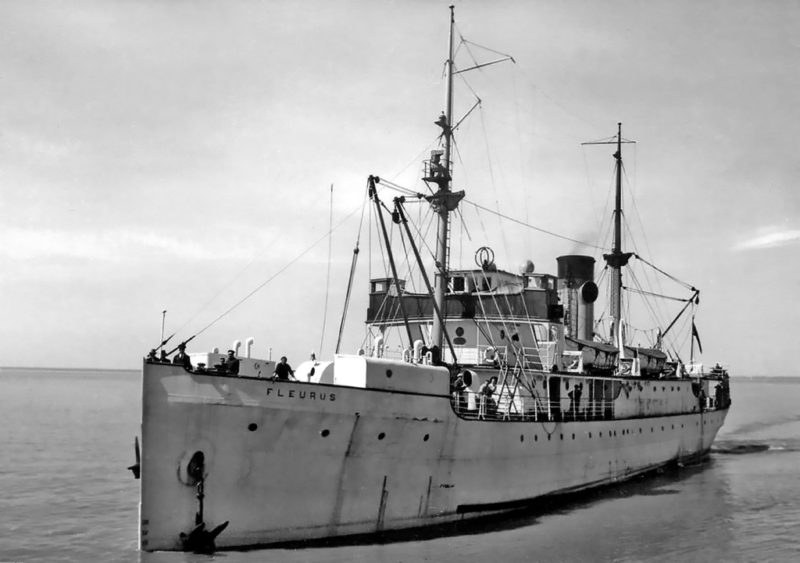
New Northland was joined in the summer cruising season of 1937 by the superb three funnelled coastal passenger ship Prince Henry of 6,892 grt renamed as North Star for the Clarke marketed ‘Vagabond Cruises’. She was chartered for the 1937 summer season in the Gulf of St. Lawrence for cruises to Bonne Bay in Newfoundland and to Labrador, and then sailed south for the Miami to Nassau cruise season. She was one of a trio of coastal passenger sisters built in 1930 for Canadian National Steamships as Prince Henry, Prince David and Prince Robert for West Coast of Canada service. They were all built by Cammell, Laird & Co. Ltd. at Birkenhead on dimensions of overall length of 385.4 feet, moulded beam of 57.1 feet and moulded depth of 27.4 feet. Six steam turbines were single reduction geared to two screw shafts and produced 14,500 shp of power to give a fast service speed of 23 knots, and they were fitted for oil fuel burning.
North Star had four passenger decks, with ‘A’ Deck having an Observation Lounge forward and an Old English Smoking Room aft, and were below the lifeboats and Masters and officers accommodation on Sun or Boat Deck, ‘B’ Deck had the Music Saloon aft, while the long ‘C’ Deck or Promenade Deck had the Cruise Director, Purser’s and Doctor’s cabins forward and the Georgian Court Lounge aft, and ‘D’ Deck below had the First Class Dining Room aft. There were many connecting cabins on Promenade Deck, ‘A’ Deck and ‘B’ Deck for passengers requiring this facility, while the dining and public rooms were served by friendly stewards, the Chief Steward having a cabin opening out onto the Georgian Court Lounge. North Star had accommodation for 335 passengers in 159 outside cabins giving superb views when cruising. She was a very handsome passenger ship when seen in profile, with a cruiser stern, and was also very useful for cargo work as she could also carry refrigerated cargo in her holds. North Star made her first West Indies cruise in January 1938, but unfortunately, neither of the beautiful Clarke coastal passenger ships of New Northland and North Star returned to their alternate summer St. Lawrence and winter Miami services after the war.
The first ship that the Clarke Steamship Company had built in Canada was the white hulled North Gaspe in 1938 of 888 grt, which sailed weekly in summer from Montréal on the South Shore service to Gaspe and the Magdalen Islands, and later from Pictou. She was also used on the shorter North Shore service in winter on the service from Pointe au Pic to Havre-Sainte-Pierre and Sept Iles. She had two masts, a short motorship funnel, was ice strengthened with passenger accommodation for 56 passengers, which was later increased to 148 passengers. The Davie yard at Lauzon were her builders and they gave her a 6 cylinder 4 SCSA Sulzer diesel from the Winterthur factory in Switzerland to give a service speed of 14.5 knots.
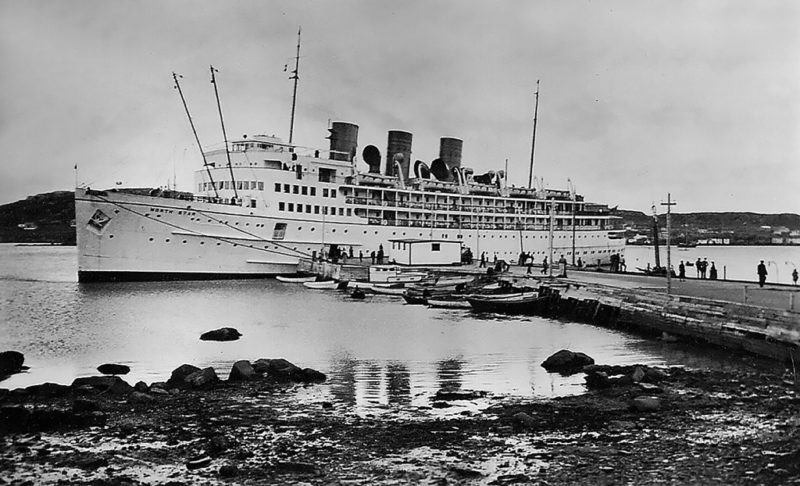
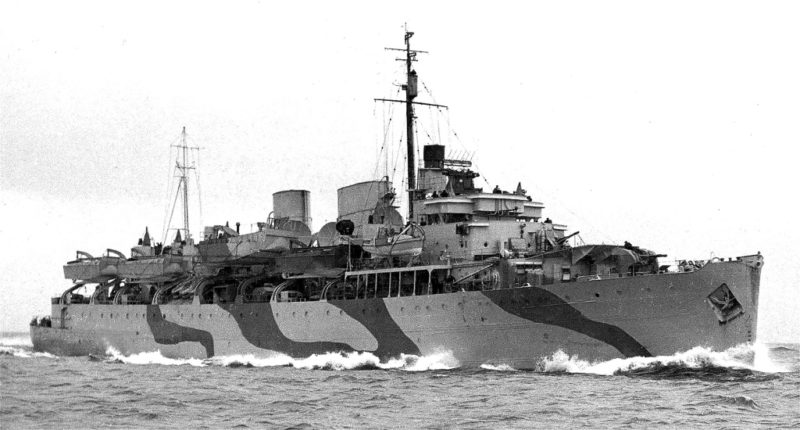
CLARKE STEAMSHIP COMPANY IN WORLD WAR II
The white hulled Clarke Steamship Company cruise ships New Northland and North Star met at Murray Bay on the North Shore two days after the outbreak of war, and it was their third meeting of that Newfoundland cruising season. The remaining few voyages were then cancelled, as was the winter Miami cruising season of 1939/40. North Star was then purchased by the Admiralty in November 1939 together with her two Canadian National sisters Prince David and Prince Robert for a total of $2.2 million for conversion into Armed Merchant Cruisers (AMC). Two of the trio were to be converted on the St. Lawrence with the third converted in the U.K. There were enough Royal Navy guns and ammunition stored in Canada, with North Star receiving four 6 inch and two 3 inch guns during the Spring and summer of 1940 during her conversion on the St. Lawrence. The Promenade and Boat Decks were cut away, and replaced by a naval cruiser superstructure with her navigating bridge moved further aft. The conversion cost $638,000 with all of her three funnels removed and replaced by two Naval type funnels, and a crew of 241 joined the renamed Armed Merchant Cruiser Prince Henry of the Canadian Navy.
New Northland was laid up at Quebec on 5th December 1939, her first winter lay up since the Depression years of 1933/34, but she was not immediately requisitioned for war service, and plans were advanced for a 1940 summer cruising season of ten cruises from 29th June to 31st August, taking in Mont-Louis, Gaspe, Perce, Anticosti Island, Baie Comeau, Tadoussac, Saguenay river, Murray Bay and Quebec. Seven of these ten cruises were successfully achieved, but the remaining three were cancelled as she had been requisitioned by the Canadian Government for use as a troop transport, and she arrived at Halifax (NS) on 21st August 1940. She sailed the next day with troops for Bermuda, continuing on to Jamaica, Aruba and Curacao with troops, and arrived back at Halifax (NS) on 13th September 1940. She then trooped to Newfoundland, Bermuda and Trinidad at the end of 1940.
New Northland sailed from Trinidad to Freetown in West Africa on 15th March 1941 and arrived at Freetown twelve days later. She came under the management of Elder Dempster Lines, and trooped to Takoradi, Accra, Lagos and Pointe Noire in the Belgian Congo until September 1942, when she was purchased by the Ministry of War Transport in London and sailed to the repair yard of Smith’s Dock Co. Ltd. at North Shields via Loch Ewe for an extensive refit. Mess decks for 500 troops were built into her ‘tween decks and cargo spaces, and her trooping capacity was brought up to 660. She then sailed from the Tyne on 13th March 1943 for Liverpool to pick up a convoy for Freetown, and trooped for three months to Bathurst (Gambia), often accompanied by the CMB troopships Elisabethville and Thysville with heavy naval escort during 1943/44.
Prince Henry had intercepted two German cargo ships when they sailed from Callao (Peru) on 31st March 1941, with their crews setting fire to them rather than being sunk by shelling, two further German cargo ships remained bottled up in that port. The AMC then continued patrols of the Caribbean, Bermuda and Newfoundland until the end of 1941. She reported to U.S. Naval Command at San Juan in January 1942 after the U.S.A. had entered the war on the Japanese attack on Pearl Harbour on 7th December 1941. She narrowly missed by the space of only one day being torpedoed in the harbour of Castries on St. Lucia on 8th March 1942, the day after U-161 had crept into the harbour unnoticed and had sunk two ships at their berths. She sailed unharmed before passing through the Panama Canal to British Columbia in May 1942 and the naval base at Esquimalt on Victoria Island. Prince Henry was then converted into a Landing Ship Infantry (LSI) by the Burrard Dry Dock Co. Ltd. by March 1943, and took part in the landings at Normandy as a Headquarters ship for Force J1 on D-Day. She then sailed from Southampton on 24th July 1944 for Gibraltar and Naples and again acted as a Headquarters ship in the landings in Southern France .
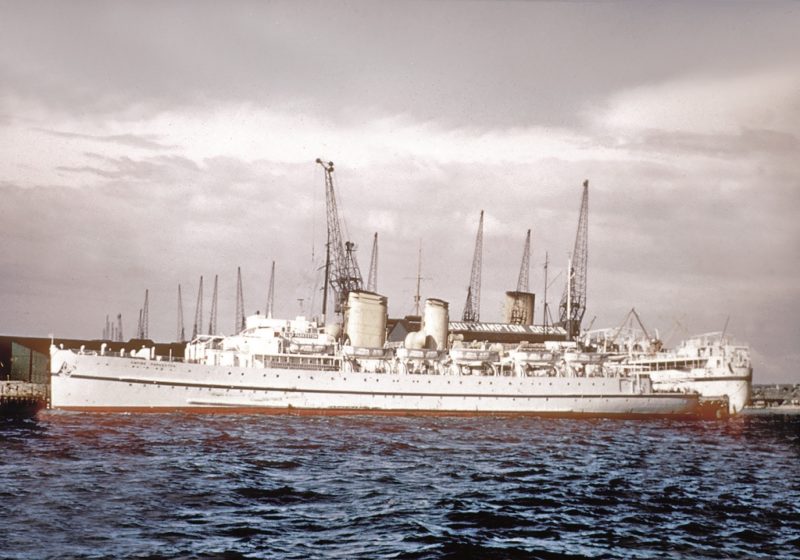
The St. Lawrence small motor vessels North Gaspe, Jean Brillant and Cape Gaspe also saw service with the U.S. Navy. North Gaspe carried troops from New York, Baltimore, Norfolk (Va) and Charleston (SC) to Newfoundland and particularly to Bermuda, but also returned to North Shore service during some summer seasons. She made 29 voyages during 1944/45 to Bermuda from Norfolk (Va), Baltimore and Newfoundland as well as helping out with Gaspesia and Sable 1 on the North Shore. The latter service was supplemented with the chartered Miron L of 264 grt, Maurice M of 221 grt, Charlenest of 143 grt and Pere Arnaud of 252 grt. Convoys had to be undertaken on the St. Lawrence from the end of May 1942 after two ships were sunk off Gaspe, including Nicoya of Elders & Fyffes.
Jean Brillant was purchased by the U.S. War Administration in 1942 with accommodation for 100 troops in the ‘tween decks, 48 officers in cabin berths, and a modest amount of cargo, and sailed from Miami. She was then chartered in December 1943 to the Ministry of War Transport in London for most of the remainder of the war on the Miami to Nassau route, escorted by submarine chasers, Coast Guard cutters and minesweepers. She often carried the Duke of Windsor, Governor of the Bahamas and the Duchess of Windsor, the former Wallace Simpson, to Miami. She made seven monthly supply runs to the U.S. naval base at Grand Cayman between August 1943 and March 1944. She was at Nassau on VE Day 1945 in her wartime grey colours with all flags flying in celebration of the end of the war. She had completed five winters and one summer on the Miami to Nassau run during the war.
Cape Gaspe was purchased by the U.S. War Shipping Administration in 1942 and served in the Jamaican port of Kingston before passing through the Panama Canal to Barranquilla in Colombia, but did not return to Clarke service at the end of the war.
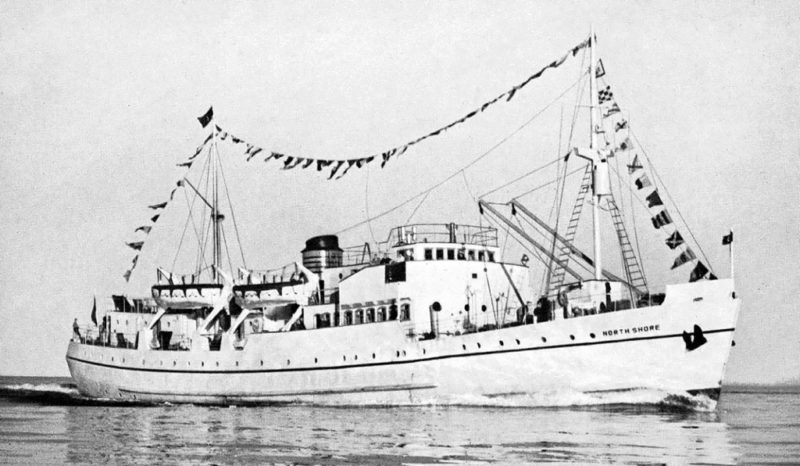
CLARKE STEAMSHIP COMPANY POST WWII SERVICE
The Clarke Steamship Company did not lose any ships to enemy action during the war, but neither of their main Newfoundland and Miami cruising ships were returned to the company in the summer of 1945. New Northland was sold for service at Jackson-ville in 1946, and North Star was sold and employed on the Harwich to Hook of Holland service of the Ministry of Transport as Empire Parkeston. Gaspesia, North Gaspe of 1938, and the partly owned Sable I were the only survivors. Gaspesia was renamed North Voyageur in 1946 and was sold in 1950, while Sable 1 was renamed North Trader in 1947 before being sold at the end of that year. North Gaspe was retained by Clarke to continue her weekly sailings from Montréal to Gaspe and the Magdalen Islands during the eight month ‘open’ season on the South Shore service, and sailed during the ‘closed’ winter iced-up season on the shorter North Shore service from Pointe-au-Pic to Sept Isles and Havre-Sainte-Pierre. Piers 34 and 35 were the busy piers at Montréal for the North Shore service.
In 1946, replacements for war losses were three ‘China B’ Class coastal types built in British Columbia yards of 1,650 dwt, with accommodation for a dozen passengers in the ‘midships bridge, triple expansion steam engine aft, and six derricks on three goalpost masts of up to ten tons capacity, and two sideports to work two holds. They had dimensions of overall length of 224 feet, beam of 37 feet, and 75,000 cubic feet of space in two holds. They were renamed North Coaster, North Pioneer for the North Shore service, and Island Connector for the South Shore service to Prince Edward Island in the Gulf of St. Lawrence and Newfound-land service. A fourth ship entered service in 1946 after conversion from a corvette and was renamed North Shore with accommodation for 76 passengers for the service that her name indicated.
Desmond Clarke created the Inter-Island Steamship Company with a capital of $0.5 million in April 1946 to begin a service between Charlotteville (PEI) and Newfound-land ports, with the Dominion Government subsidy of $4,500 per voyage. The service used Island Connector and lasted for four seasons from April to November until Newfoundland became part of the Dominion in late 1949. Island Connector was sold in 1950 after her last run on the Halifax (NS) to St. John’s in Newfoundland service during the iced up St. Lawrence winter season. She sailed to British Columbia for a weekly cargo service between Vancouver and Skagway for Canadian Pacific Steamships as Yukon Princess.
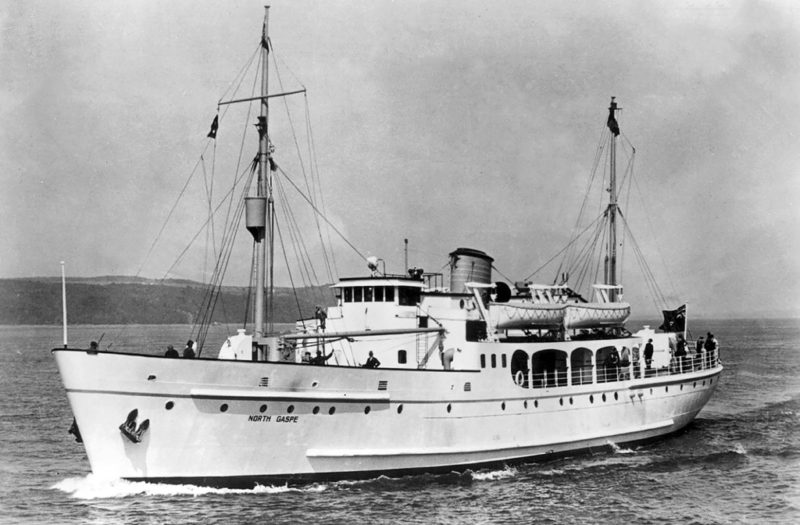
Newfoundland became the tenth state of Canada in 1949 with an area of 112,300 km2, and was joined later by Labrador to give a total area of 404,500 km2. This vast area had mineral deposits of iron ore, zinc, lead and copper, with wood pulp, paper, asbestos and aluminium produced by cheap hydroelectric power, and a large fishing industry catching cod, salmon, halibut, lobster, and a plentiful supply of seals. Sailings to the province increased dramatically from 1949, with two ‘Hansa B’ types having been purchased in 1947 as war reparations to the Canadian fleet, with Empire Gatehouse renamed Gulfport in 1947 and Empire Gangway retaining her name until becoming Novaport in 1950.
Three more owned ships joined the fleet during the period 1957 to 1960, two cargo ships in Highliner of 4,036 dwt, with two holds forward of the bridge and one hold aft, and the engines aft Yorkwood of 3,130 dwt, and the new passenger and cargo ship North Voyageur of 895 grt in 1958 from the Lauzon yard of G. T. Davie & Sons Ltd. The latter ship was equipped with three derricks on two bipod masts, one hinged on the bridge structure, and sailed weekly in the ‘open’ season on the North Shore service and less frequently on the winter shorter service during the ‘closed’ iced-up season. She made a total of 160 sailings on the North Shore service during her first five years of service. She was sold in 1970 and renamed Voyageur D, managed by Transport Desgagnes of Montréal, until she sank on 27th January 1972 off St. Irenee Wharf after striking a submerged object in ice, her cargo of aluminium was salvaged. Highliner and Yorkwood were initially jointly owned from 1959 to 1964 with Constantines of Middlesbrough, and then were purchased outright and registered under the Tynedale Shipping Co. Ltd., a Clarke company. Yorkwood had been completed in 1950 as Benin for Elder Dempster Lines service in West Africa until purchased in 1960 and renamed, and again registered under the Tynedale Shipping Co. Ltd.
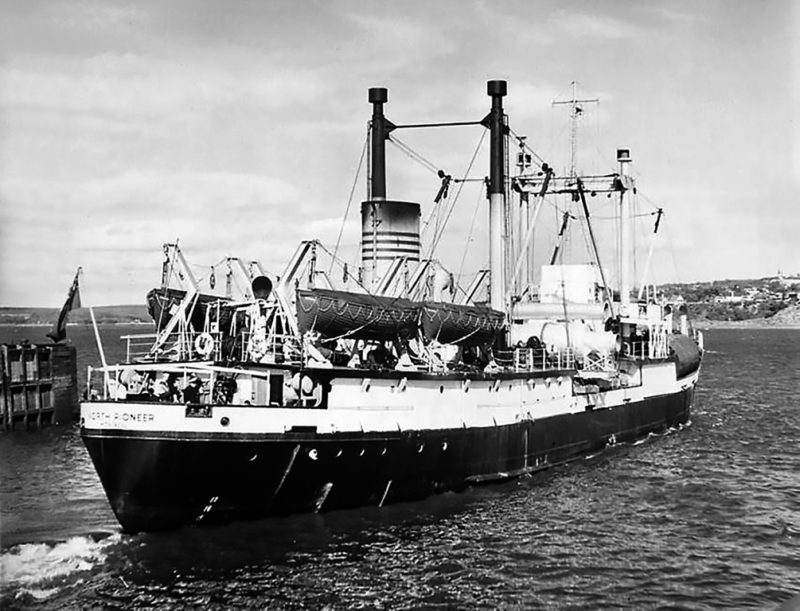
NORTH SHORE SERVICE 1946-1962
This service was the most important Clarke service during this period with a large number of owned and chartered ships employed on an average of 200 sailings per year, 80 by owned ships and 120 by chartered ships. Due to the St. Lawrence being iced up for four months of the year, a shorter North Shore service was offered from Pointe-au-Pic to Sept Isles and Havre-Sainte-Pierre with an average of 20 sailings per year by both owned and chartered ships. The North Shore Service began to decline from 1963 onwards due to air competition with a three times weekly service offered in 1965, and was discontinued in 1967.
SOUTH SHORE SERVICE 1946-1960
The passenger and cargo ship North Gaspe sailed weekly and made an average of 30 sailings per year on the South Shore service during the ‘open’ season on the St. Lawrence, and then during the four month iced-up ‘closed’ season she transferred to a shorter North Shore service from Pointe-au-Pic to Sept Iles and Havre-Sainte-Pierre service, making an average of ten sailings per year before her sale in 1962. The South Shore Service declined rapidly from 1961 with only one sailing per week in 1965 until it was discontinued in 1967.
NEWFOUNDLAND
Regular passenger and cargo services were offered from 1946 from Quebec to St. John’s, with an average of 40 sailings per year during the ‘open’ ice free St. Lawrence season, and then an average of ten sailings per year from Halifax (NS) to St. John’s during the closed ‘iced-up’ season. Sailings from Quebec to Corner Brook on Newfoundland also began in 1946 with an average of 30 sailings per year by owned and chartered ships. The owned Novaport and Gulfport took the vast majority of the owned ship sailings, with one in five voyages also calling at North Shore ports en-route to Newfoundland. Sailings to Botwood and the North Coast of Newfoundland began in 1959, with an average of 8 voyages per year by owned ships and 48 voyages per year by chartered ships.
LABRADOR
Clarke voyages to Goose Bay in Labrador at the western end of the very long 120 mile in length Lake Melville from the salt water entrance at Hamilton Inlet began in 1955, with an average of 8 sailings per year, all by chartered ships.
CHARTERED SHIPS DURING THE PERIOD 1946-1973
A vast armada of chartered ships of all sizes and descriptions supplemented the owned fleet on the North Shore service, South Shore service, and the Newfoundland services to St. John’s, Corner Brook, and Botwood and the North Shore. Chartered ships also operated to Goose Bay in Labrador, and in smaller numbers to Churchill in Hudson Bay. Mont-St-Martin of 493 grt was a new motor coaster completed in 1957 by the Lauzon yard of G. T. Davie & Sons Ltd. and was chartered for 16 years until 1973 making around twenty sailings per year on the North Shore service until 1967, and then sailed on other Clarke services. The small, one hold, two hatch, two derricks, engines aft coaster Fort Levis of dimensions 130 feet by 26 feet made 200 voyages on the North Shore service during the ten year period from 1953 to 1962. Similar sized motor coasters, with the quaint names of Zipper and Blue Laker, made a total of 14 voyages to Goose Bay during 1955 to 1960. Zipper unfortunately ran aground on 14th July 1956 on the Shag Rocks in Hamilton Inlet on her way to Goose Bay, but was towed off by a tug.
D’Vora was a converted ‘Isles’ class trawler named Kittern, and was converted for commercial service in 1947 for the Ezra Deep Sea Shipping Co. Ltd. of Tel Aviv and had five other owners until she was chartered by Clarke in 1959. She was wrecked on 26th December 1968 at St. Yvon near Claridorme on the Gaspe coast. Guard Mavoline of 465 grt was also a converted trawler built in 1941 and was chartered by Clarke from 1956 and used on both the ‘open’ and ‘closed’ North Shore services. The standard British built ‘F’ class coaster Empire Fang became Canadian owned as Longboat by G. Harvey of Quebec, and completed 40 chartered voyages on the North Shore service between 1955 to 1961, with a new diesel engine installed in 1956. The bulk cement carrier Farrandoc of 2,900 dwt was chartered by Clarke for 77 cargoes of bulk cement for huge hydro-electric dams of Hydro-Quebec construction projects at Manicouagan, and was a typical ‘Canaller’ with engines aft and bridge forward over the bows and was owned by N. M. Paterson & Sons Ltd. of Fort William at Thunder Bay on Lake Superior. D’Auteuil II was a wooden coastal schooner owned by the Desgagnes family and launched in the Spring of 1945 for the D’Auteuil Lumber Company and acquired by the Desgagnes family in 1949, and made 43 voyages for Clarke during the ten year period from 1953 to 1962.
Aigle D’Ocean was a converted ‘Saint’ class steam tug built in 1919 as St. Arvans and made 43 chartered voyages for Clarke during 1961/62 while owned by the Desgagnes family. A long career of 56 years came to an end on 20th August 1975 when she was returning from a voyage to the Canadian Arctic in transit through the Hudson Strait from Koartak in Northern Quebec to Quebec City. She developed a heavy list due to water ingress and sank with a Canadian Coast Guard icebreaker only able to rescue five of her nine crew members. A further tragic loss of two lives occurred when the helicopter of the icebreaker crashed near the shore during the rescue operation. Aigle Marin of 489 grt, Mont St. Martin of 402 grt, Mont St. Ste Marie of 350 grt, Fort Severn of 373 grt, and Maurice Desgagnes, the latter equipped with derricks on three goalpost masts, were other Desgagnes family coasters chartered to Clarke.
Ahern Trader made 25 chartered voyages for Clarke during 1955/57 and had been built back in 1922 by A. & J. Inglis at their Pointhouse yard on the Clyde as Lurcher of 774 grt for Burns Line, becoming Scottish Coast in 1925 and Ulster Coast in 1938 for the Belfast Steamship Co. Ltd. of the Coast Lines empire, and Ahern Trader for Canadian owners in 1954. She was wrecked on 10th January 1960 in Gander Bay on the north coast of Newfoundland after arriving with a cargo of hay two days earlier at Frederickton. She was on charter to the Canadian National Railway and as the ship was leaving port to return to Victoria Cove a Force 10 gale with heavy snowfall and a blizzard struck her, and she sank only 40 metres from the shore. The crew were fortunately rescued but the ship was a total loss
Rexton Kent was a converted ‘Flower’ class corvette named Candytuft built in 1943, and she made six chartered voyages for Clarke in 1959, and was later scuttled off Nova Scotia in 1966. The Greek owned engines aft Ithaca of 2,057 grt had been launched back on 21st October 1922 as Frank A. Augsbury for Canadian owners by Frazer Bruce Ltd. at Trois Rivieres, later becoming Granby for Canada Steamship Lines (CSL), Lawrence Cliffe Hall for Hall Corporation of Canada, and Ithaca in 1960. She had gained a diesel engine instead of her original triple expansion steam engine, and was chartered by Clarke at Montréal in September 1960 and sailed in ballast to the Rankin Inlet nickel mine, 300 miles north of Churchill, to transport 3,000 tons of nickel ore to Churchill on Hudson Bay. After her discharge, the ship was loaded with supplies, mining equipment and some prefabricated housing units. The crew had not been paid for over two months, but after payment was arranged, she headed back to Rankin Inlet. She was only 12 miles east of Churchill near Bird Cove when a storm hit her, and with her anchors dragging she ran aground after her anchor cable snapped on 14th September 1960. The crew were fortunately rescued but her double bottom was completely ripped out, and the ship rests today in a vertical position as a slowly rusting hulk on a reef.
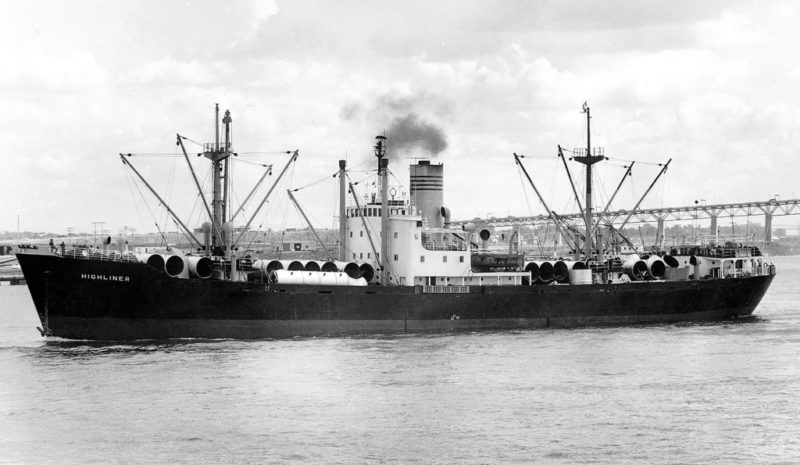
The Newfoundland services of Clarke used larger coasters of up to 3,000 dwt from the following British and Irish companies:-
Dundee, Perth & London Shipping Co. Ltd., Dundee
Dundee (1,781 grt), Gowrie (1,923 grt), Perth (964 grt), London (706 grt) and Lunan (1,018 grt), the latter as the Canadian owned Maridan C during 1960/62.
General Steam Navigation Company (GSNC), London.
Sheldrake (1,923 grt), Grebe (933 grt) and Woodcock (959 grt).

Constantine Lines, Middlesbrough.
Avonwood (1,874 grt) and Eastwood (1,793 grt).
W.A. Phillips, Anderson & Co. Ltd., London.
Admiral Fraser (2,276 grt) launched at the Southwick, Sunderland yard of William Pickersgill & Sons Ltd. in 1948, making 11 chartered voyages for Clarke in 1953 before her sale in 1954 to the Australasian United Steam Navigation Company of Melbourne as Canberra and Cronulla, and later to John Manners & Co. Ltd. of Hong Kong. She was wrecked at Hong Kong on 1st September 1962 during a typhoon.
Thomas Leitch Shipping Ltd., Liverpool.
Elespoint (1,787 grt) built in 1919 as Ravens Point for MacAndrews by H. & W. Grayson at Garston, making 10 chartered voyages to Newfoundland for Clarke in 1956.
Leighton Shipping Co. Ltd. Guernsey.
Alderney (3,994 grt) and Guernsey (1,363 grt) made 18 chartered voyages for Clarke to Newfoundland during 1957/59.
George Gibson & Co. Ltd., Leith
Melrose (1,076 grt) made 11 chartered voyages for Clarke to Newfoundland in 1959.
Irish Shipping Ltd., Dublin
Engines aft Irish Rose (1,749 grt) and sister Irish Willow (1,743 grt), built by the Ailsa yard in Troon in 1956, made 34 voyages for Clarke to Newfoundland during the ‘open’ season of April to November, 1960.
W France, Fenwick & Co. Ltd., London
Dashwood (2,156 grt) made 29 voyages on the coal, pitch, cement, grain, copper concentrates and general cargo trades on the St. Lawrence and Newfoundland routes during 1958 to 1960, plus nickel ore cargoes from Rankin Inlet to Churchill on Hudson Bay. The owned ship Yorkwood took over the nickel ore cargoes in 1961.
Hudson Steamship Co. Ltd., London
Hudson Sound (2,577 grt) made around 100 chartered voyages during the seven years from 1958 to 1964 inclusive, employed on all of the Clarke trades.
Manchester Liners Ltd., Manchester
The Canal sized Manchester Explorer (1,803 grt) made 4 chartered voyages for Clarke during 1960/62
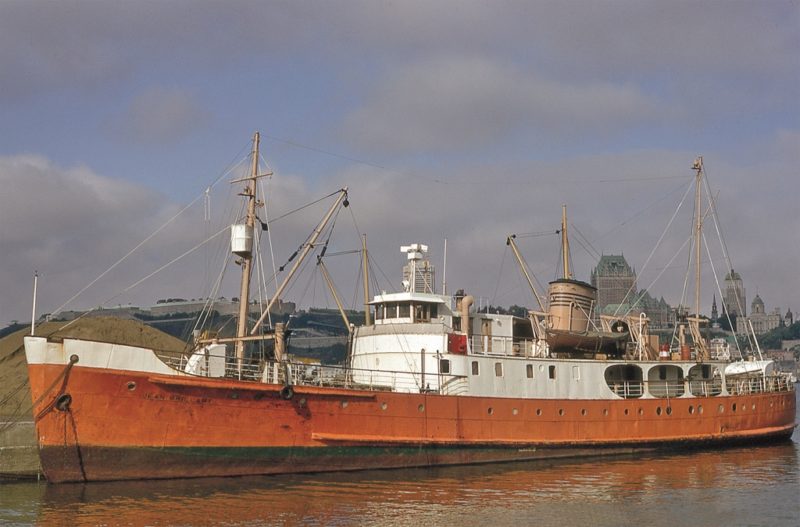
ST LAWRENCE CROSSING FERRIES MANAGED BY CLARKE
A company was formed in 1919 for passenger and cargo services crossing from Rimouski and Matane to ports on the North Shore between Baie Comeau and Sept Iles and Blanc Sablon. The Lower St. Lawrence Transportation Co. Ltd. service was terminated in 1969 when the Government subsidy was transferred to the Maritime Agency Inc. Small crossing ferries such as Manicouagan of 85 grt, Mayita of 112 grt, and Marco Polo of 141 grt carried on the service until a new, larger, yacht like motor vessel was completed on the Tyne by the Neptune yard of Swan, Hunter & Wigham Richardson Ltd. as Jean Brillant of 640 grt in 1935.
Jean Brillant was ice strengthened and had an overall length of 169 feet, moulded beam of 29.1 feet with a draft of 10.8 feet, with accommodation for 139 passengers, 36 of these in berths. A service speed of 12.5 knots was achieved from a six cylinder 2SCSA oil engine by her builders at the Neptune Engine Works. She shared the crossing service with two new smaller motor vessels completed in 1938/39 as Matane of 470 grt with accommodation for 120 passengers, 14 in berths, and Rimouski of 348 grt with accommodation for 120 passengers, ten in berths. The Sorel yard of Marine Industries Ltd. completed both of these motor vessels, and all three continued the service until the 1960s except for war service. Jean Brillant was fitted with radar at the end of the war, and reopened the Clarke cruising service from Miami to Nassau with a white hull during the ‘closed’ St. Lawrence season from December 1945 to April 1946 in an effort to continue the marketing of ‘Vagabond Cruises’ that Clarke had run so well in pre-war days, and also continued to market on the North Shore passenger service in post-war days.
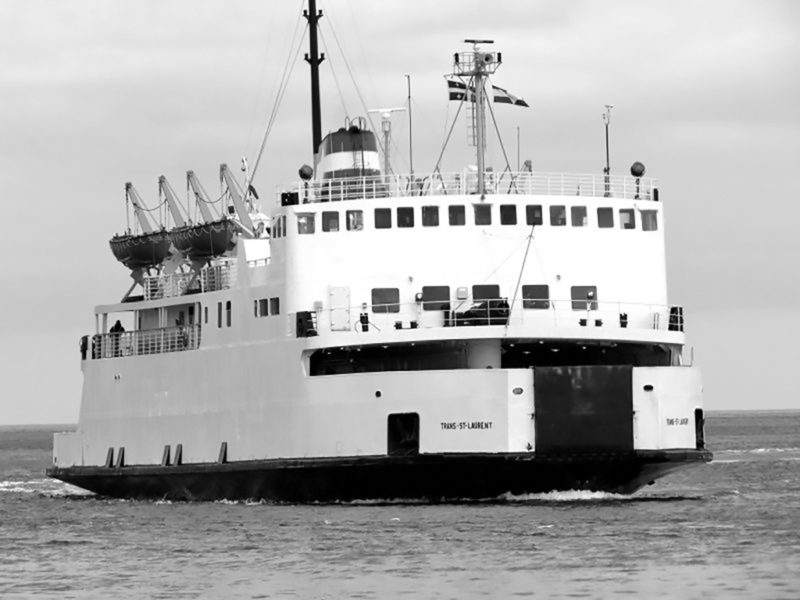
A company was formed in 1930 for the St. Lawrence crossing service from Riviere-du-Loup on the South Shore to Tadoussac at the entrance to the Saguenay river on the North Shore and initially used the old ferry Riviere du Loup of 1,650 grt with accommodation for 600 passengers, renamed St. Simeon in 1939 and placed in reserve, and a newer Riviere du Loup of 1,491 grt with accommodation for 250 passengers on the service of La Traverse Riviere-du-Loup to Tadoussac Ltee from 1939. The service received a larger double ended ro-ro ferry in 1963 in Trans St. Laurent of 2,173 grt from the Lauzon yard of G.T. Davie & Sons Ltd. with accommodation for 450 passengers, later increased to 500 passengers, and a capacity of 70 cars. She had an overall length of 262.0 feet, moulded beam of 62.3 feet, with a service speed of 13.5 knots from a B & W oil engine of 2,000 bhp. She completed a long service period of 50 years in 2013, and had been joined by the smaller Radisson of 1,149 grt, built in 1954, but was sold to the Quebec Government in 1974 and chartered to the Traverse Riviere du Loup to Simeon Ltee and managed by Clarke.
A company was formed in 1940 for the ferry service across the entrance of the Saguenay river from Baie Ste. Catherine to Tadoussac, which continued for forty years until 1980.
The small ferries Jacques Cartier of 228 grt, built in 1924 with accommodation for 88 passengers, and Louis Herbert of 248 grt, built in 1929 operated this service for the Compagnie de Navigation Charlevoix-Saguenay Ltee. In post-war years, the new ferries Le Sorelois of 157 grt, Saguenay of 429 grt with accommodation for 200 passengers, Charlevoix of 535 grt with accommodation for 200 passengers, and Pierre de Saurel of 538 grt with accommodation for 320 passengers ran the service, all managed by Clarke.
Two further ferry services were also managed by Clarke, the service from Pictou (NS) and Charlotteville (PEI) to the Magdalen Islands from 1945 to 1970, and the ferry service from Ste. Anne-des-Monts (near Matane on the South Shore) to Sept Iles on the North Shore from 1960 to 1969, when the service terminated.

NEW SHIPS FOR NEW AND OLD TRADES
The Clarke Steamship Company had its busiest ever year in 1960 with no fewer than 500 scheduled passenger and cargo services that year, together with very many chartered voyages in the bulk trades e.g. aluminium ingots and nickel ore. Clarke ended both the North Shore and South Shore passenger and cargo services on the St. Lawrence in 1967. Air competition had caused the sale of all of their passenger ships, and except for two or three St. Lawrence crossing ferry services, the company then concentrated on cargo work.
Clarke Traffic Services Ltd. had been incorporated on 26th March 1962 with offices in Montreal and Halifax (NS), with Stanley Clarke holding 60% of the shares and his brother Brock Clarke holding 40% of the shares.
The company operated all of the pool car services of Clarke, including a brief service from Montreal to Toronto on the Great Lakes during 1962/63 by the owned ship Highliner in a joint service with Newfoundland Great Lakes Steamships.
Chimo-Clarke Northern Services was formed in 1963 in a joint operation with Chimo Shipping Ltd. to Newfoundland, Goose Bay in Labrador, Rankin Inlet to Churchill in Hudson Bay with nickel ore, and Arctic services in Frobisher Bay and Coral Harbour.
The Port Weller built sisters Chesley A. Crosbie and Sir John Crosbie of 1,900 grt were employed with asbestos cargoes from Baie Verte on the north coast of Newfoundland, together with four more of the fleet of Chimo Shipping Ltd. to carry out between thirty and fifty voyages per year during the period 1963/65, and over thirty voyages in 1966. Chimo Shipping Ltd. then became a frequent source of chartered ships from 1967, and in September 1980, Clarke and Chimo Shipping Ltd. agreed to combine their services to Newfoundland, with Clarke using their two vessels Cabot and Chimo, and Chimo using A. C. Crosbie, the former Ida Lundrigan of Common Brothers of Newcastle, and also Lady M. A. Crosbie, the former Baltic Vanguard of United Baltic Corporation (UBC) and bareboat chartered in 1981. Chimo Shipping Ltd. was, however, declared bankrupt on 22nd July 1981 for non payment of shipyard repair bills.
On 20th December 1963, Stanley Clarke ordered the first of two, new and efficient, side loading, ‘tweendeckers for the company services to St. John’s (NFL). The ships were ordered from the Davie Shipbuilding yard at Lauzon, with their plans based on the general arrangement plans of the recently built Fort St. Louis of Canada Steamship Lines (CSL). The cost of each ship was high at $5.675 million and they had dimensions of overall length of 471.0 feet, moulded beam of 56.0 feet, and were of 6,020 grt and 7,900 dwt. Slow speed Sulzer diesel engines gave a service speed of 17 knots on a fuel consumption of 25 tons per day. Cabot (Yard number 649) was launched on 12th May 1965 and completed at the end of June, making 26 voyages during her first season to St. John’s, and then switched to the winter Halifax (NS) to St. John’s service.
Chimo, her near sister, was launched on 27th June 1967 from the same yard as Yard number 662 and was completed on 15th August 1967. She was, for financial reasons, bareboat chartered from Canada Steamship Lines (CSL), and registered under another new Clarke company named Clarke Transportation Canada Ltd. Chimo had three hatches, one less than Cabot, but was almost identical, with each ship providing one weekly voyage between Montreal and St. John’s (NFL) equipped with twin cranes of 20 tons capacity, radar, controllable pitch propellers, ice strengthening to Ice Class 1, and automated navigating bridge controls. Chimo and Cabot loaded 100 TEU of containers on their open decks, with each container emblazoned with ‘Clarke Traffic Container Service for Newfoundland Steamships’.
Fort St. Louis was chartered by Clarke for ten years from 1970 to 1980 for the service to Corner Brook each summer. Cabot unfortunately capsized onto her port side on 16th December 1966 while loading at Shed 68 at Montreal in 30 feet of water, with two people killed and nine injured. After refloating over one month later, she spent four months at the repair yard of Marine Industries Ltd. and returned to service on 8th June 1967. Cabot and Chimo had their funnels repainted after 1972 to the new more modern Clarke colours with a white central band carrying a large white diamond in the middle of the band.
Clarke then became interested in the Transatlantic trades in 1967, with timber carriers chartered from Eastern Canada ports to European ports. In a move to deep sea shipping, Clarke Traffic Services Ltd. took a one third interest in a new Transatlantic container line, Dart Container Line, when it was formed in June 1969 by Bristol City Line, Clarke Traffic Services Ltd., and CMB of Belgium. Offices were in Bristol, Antwerp, Montreal and New York, with another office at Reid House, Hamilton, Bermuda where the company was registered.
Three sister container ships of 1,535 TEU capacity were ordered, two from the Tyne yards of Swan Hunter Shipbuilders Ltd., and one from Cockerill Yards in Hoboken, Belgium. They were completed in 1970 as Dart America (the Clarke ship), Dart Atlantic (the Bristol City Line ship), and Dart Europe (the CMB ship). They measured 31,036 grt on dimensions of overall length of 760.0 feet, moulded beam of 100.5 feet, with a fully loaded draft of 33.1 feet, and a service speed of 22 knots from a Clark-Sulzer diesel engine of 29,000 bhp. However, Clarke sold out in May 1973 to Bibby Line, which then passed the interest to C. Y. Tung of Hong Kong three months later.
The Clarke sideloaders of Cabot and Chimo, and the similar chartered Fort St. Louis, continued their services to St. John’s during the 1970s, and were in the Clarke fleet on 10th October 1981 when the Clarke Group of shipping companies was taken over by Newfoundland Capital Corporation (NCC) of Gander for $18.5 million, thus gaining control of all the Clarke Group shipping companies, plus a half interest in Newfoundland Steamships, and a one third interest in and the management contract of the Halterm Container Terminal at Halifax (NS).
The first chartered container ship to call at Halifax (NS) was the German owned Jorg Kruger on 17th July 1969, and after the completion of Halterm Container Terminal in 1970, large container ships of many lines called, including Zim Lines and OOCL of C. Y. Tung.
The investment company of brothers Stanley Clarke (then aged 64 years) and his brother Brock Clarke had been suggested by a stock broker working on behalf of NCC as a takeover possibility. Stanley Clarke retired in 1982, and the last Annual General Meeting of the Clarke Steamship Company was held in 1983 and was wound up on 20th September 1985. Stanley Clarke was born on 18th December 1917 in Quebec as the son of Desmond Clarke, and graduated in Mechanical Engineering at Queen’s University. He served in the Canadian Army with distinction during World War II in North Africa and Europe as a Lt.-Colonel in charge of operations of 1st Canadian Workshop, a unit of 3,500 troops. He joined Clarke Steamship Company in 1946, and on the retirement of his father from management of the company in December 1958, he served as President until 1982. He died on 25th January 2006 aged 88 years, surrounded by his large family and friends.
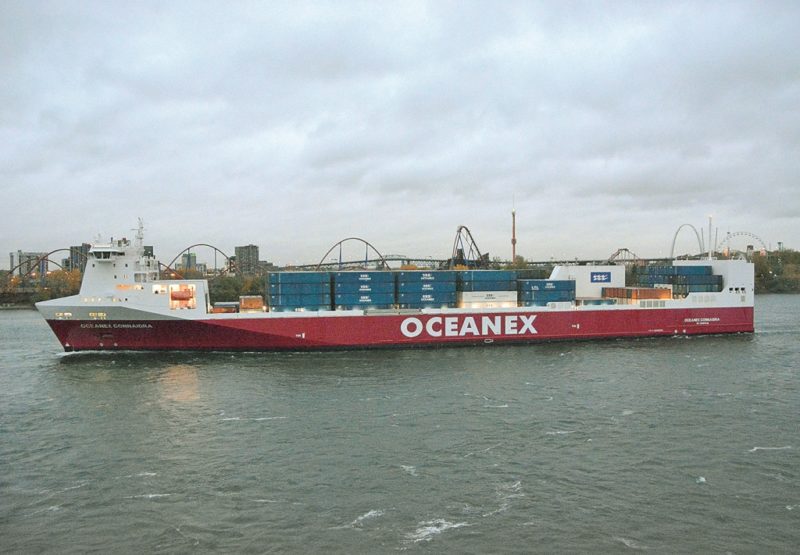
SUCCESSOR COMPANIES WITH CLARKE INTERESTS
On 25th June 1982, Atlantic Container Express (ACE) was formed by Newfoundland Steamships, a Clarke company, and Atlantic Freight Lines, with Clarke holding a half interest, Canada Steamship Lines (CSL) holding a quarter interest, and A. Harvey & Co. Ltd. having a quarter interest. Giles Champagne became President and CEO of ACE, who then closed the Montreal to Corner Brook service to concentrate on St. John’s. ACE had only two container ships at this time in Lady M. A. Crosbie and Catalina.
The latter was the former Inishowen Head of 10,545 dwt, built in 1965 by Austin & Pickersgill Ltd. at Southwick in Sunderland for Head Line of Belfast (G. Heyn & Sons Ltd.), and converted into a container ship of 370 TEU capacity in 1970 for a joint Transatlantic service with Donaldson Line of Glasgow. She was then chartered to Cast Line in 1973 as Cast Beaver, and bareboat chartered in 1982 as Catalina by Northern Steamships Ltd., a Clarke company, until laid up at Montreal in 1984.
The twin screw ro-ro container ship Cicero of 10,919 grt was purchased by ACE in May 1984, and replaced both the existing container ships of Lady M. A. Crosbie and Catalina. Cicero had been completed in 1978 by the South Bank yard of Smith’s Dock Co. Ltd. at Middlesbrough for Ellerman Wilson Line service to Scandinavia. She had dimensions of overall length of 485.0 feet, moulded beam of 72.1 feet and a loaded draft of 22.7 feet, with a service speed of 18 knots from a diesel engine of 14,600 bhp.
In March 1988, a near sister was purchased as Cavallo, built by the same yard in 1979 but 90 feet longer with the same beam as Cicero, and she was renamed Cabot (2). At the end of 1988, ACE was using three container ships in Cicero, Cabot (2) and the chartered Lucien Paquin. At the end of 1990, two competing lines were operating to St. John’s in ACE, with a half interest by Clarke and operating three ships from Montreal to St. John’s and Corner Brook, and Atlantic Searoute Line (ASL) with Fednav holding a 50% interest, and CSL and A. Harvey each holding a 25% interest, and two ships operating from Halifax (NS) to St. John’s and Corner Brook. ACE and ASL were merged in January 1991 into Oceanex Ltd. Partnership with Giles Champagne as President and CEO.
Cicero was sold out of the Oceanex fleet in 2006, and Cabot (2) was sold out of the Oceanex fleet in 2014, with three ro-ro container ships operating for the company today. The oldest is Oceanex Sanderling of 21,849 grt with a ro-ro capacity for 1,127 TEU of containers, and had been built in Sasebo in Japan as Raunbenfels for Hansa Line of Bremen. After two changes of name, she was purchased in 1987 by Atlantic Searoute Line (ASL) and renamed ASL Sanderling, becoming Oceanex Sanderling in 2008. Oceanex Avalon of 14,539 grt and 14,747 dwt is a ro-ro containership completed in 2005 by J. J. Sietas of Hamburg with an overall length of 149.0 feet, moulded beam of 26.0 feet and a loaded draft of 7.6 feet, and Oceanex Connaigra of 26,768 grt is a twin screw ro-ro containership completed in 2013 by Flensburger Schiffbau in Germany with an overall length of 689.0 feet and a moulded beam of 91.9 feet and a service speed of 23 knots from a diesel engine of 23,000 bhp. Oceanex ro-ro container ships have red hulls, and white funnels with an Oceanex logo, and the company has the well known Capt. Sid Hynes as Executive Chairman. Capt. Hynes has 35 years experience as a Ship’s Master and in the shipping, transportation and oil and gas sectors, and became Chairman of Oceanex Ltd. Partnership in 2016 when he purchased the company for $230 million.
The Narrows in the harbour entrance to the capital of St. John’s are only 61 metres wide at the narrowest point, making a tight squeeze for the big freight ro-ros of the Oceanex Ltd. Partnership freight service from Montreal and Quebec of Oceanex Sanderling, Oceanex Avalon and Oceanex Connaigra. A very skilled pilot is needed to get these freight ro-ros through to their berths in the wide harbour, with the wharves also acting as bases for oil rig supply vessels, trawlers, small vessels under repair and other craft. The St. John’s pilots describe getting these freight ro-ros into and out of port as akin to ‘threading the eye of a needle’. Fort Amherst was built in 1763 on the opposite south bank to Signal Hill in The Narrows, and Fort Amherst Lighthouse, now a heritage site, was erected at South Head to guide approaching ships into the harbour. The Furness, Withy coastal passenger ship Fort Amherst was named after this fort.
POSTSCRIPT
A big thank you is due to Kevin Griffin of The Cruise People Ltd., whom I first met at his office in London 25 years ago in April 1996 as we were planning the joint production of a book entitled ‘St. Lawrence Saga’ on the Clarke Steamship Co. Ltd. to be published by my publishing company. However, for one reason or another, the book was never published, but later Kevin wrote it and uploaded it to the Internet in 2014 for everyone to read at their leisure at www.clarkesteamship.wordpress.com and consists of fourteen long chapters, fifteen ship photographs and three appendices including a full fleet list.
I wish to sincerely thank Kevin Griffin for this completed work. He has a very deep knowledge of the history of St. Lawrence shipping and worked for Clarke from June 1969 to July 1977, and Fednav of Canada for many years before moving in March 1986 to London to start up a new service for Fednav with the ro-ros Federal Lakes ex Avon Forest and Federal Seaway ex Laurentian Forest. These ro-ros were built by Port Weller Dry Docks in 1972/73 on a summer dwt of 20,545 metric tonnes without stern ramps, having instead two side ramps on the starboard side, one forward and one aft, and four internal elevators and one weather deck hatchway.
The iconic Clarke Steamship Company sideloaders Cabot and Chimo of 1965/67 were later converted into Great Lakes bulkers with the addition of new hull sections, Cabot became Canadian Explorer in 1983, Canadian Transfer in 1998 and Algoma Transfer in 2011 and was laid up later that year at Goderich, and was broken up in 2014 at Port Colborne in Ontario. Chimo, her near sister, became Canadian Ranger in 1984, and was later broken up at Aliaga in Turkey in 2011. The similar prototype designed ship of this pair, Fort St. Louis completed in 1963 for Canada Steamship Lines and chartered by Clarke in 1967 as a replacement for Cabot during her repairs, and also chartered from 1970 to 1980, was towed from Montreal on 6th October 1993 bound for Mamonal in Colombia for breaking up.

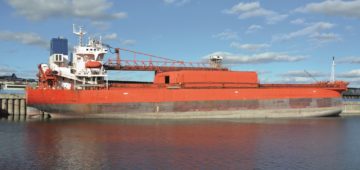



Comments
Sorry, comments are closed for this item